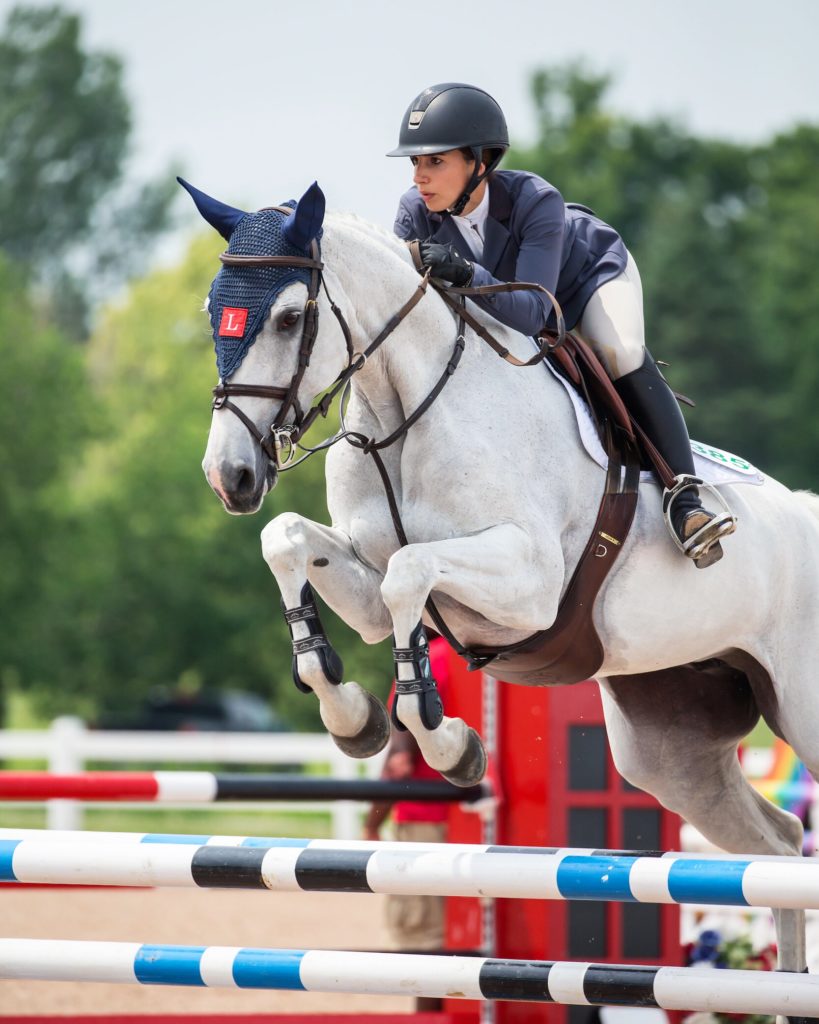By Olivia Minicucci, BSc, MS
Alert! It’s going to be a hot one! While riders may try to beat the heat when they compete, dehydration can cause serious damage to athletic performance. Gloves. Helmet. Breeches. Boots. Show coat. Not to mention that riders sit on a heat-emitting horse, while under the blazing sun. Needless to say, riders sweat…a lot. Check out these tips on how to stay hydrated, and how to assess your fluid and electrolyte needs.
 Doing this ONE thing can improve your riding performance. Photo by Ben Radvanyi.
Doing this ONE thing can improve your riding performance. Photo by Ben Radvanyi.
How Dehydration Can Impact Your Riding
Do you have difficulty remembering a course, inside turns, or stride counts? Are you constantly fatigued, experience muscle cramps, or feel like you are working harder than usual? These are all negative signs and symptoms of dehydration. It only requires a 2 to 3% body weight loss from sweat to negatively impact your performance. (1) So, the seemingly obvious solution would be to drink more water, right? In fact, due to the high sweat rate of riders, especially while wearing competition attire, drinking water is only one piece of the puzzle. Sweat is primarily composed of a combination of water, sodium, and potassium. These nutrients are known as the body’s electrolytes, which are critical for complete hydration. If training exceeds an hour, water can’t do it alone! (1)
Use the following electrolyte replenishment chart to better your riding performance. Mix and match items from each column for complete rehydration. Some choices even overlap in nutrients!
| Fluid | Foods High in Potassium | Foods High in Sodium |
| Water | Dried Apricots/Raisins/Prunes | Salted Nuts |
| Herbal Tea | Cantaloupe | Low-fat Cheese |
| Sparkling Water | Avocado | Pretzels |
| Decaffeinated Coffee | Banana | Salted crackers |
| Orange Juice | Salted Pumpkin Seeds | |
| Coconut Water | Marmite | |
| Low Sugar Sports Drink (Ex: G2) |
How Much Should Riders Drink?
Much like with nutrition, hydration is an individualized process. In an ideal world, riders should consume water throughout the day, at meals, and during rides. While the idea of stopping for a water break during a ride may seem impossible, utilize your course review time at the in-gate, or between exercises during a lesson. Don’t let your performance and focus suffer over something preventative!
Generally speaking, in the few hours leading up to a lesson or show division, riders should consume about 16 oz of fluid. Keep in mind that fluid needs are increased during times of heat, humidity, travel, intense training, altitude, and illness. In other words, riders need to drink more when they are away at shows and during challenging lessons. If you are a rider who chronically forgets to drink throughout the day, try to keep your water bottle handy. There is a reason people say, “out of sight, out of mind.” By having it close by, you will be more inclined to drink from it. Not a water drinker? Try increasing fluids through a fruit and veggie smoothie or herbal tea!
How to Monitor Your Hydration Status
The main ways for riders to assess their level of hydration is through thirst, daily weight fluctuations, and urine color. However, if you’re thirsty, it’s already a sign of insufficient hydration. But, before you start chugging an excessive amount of water, consider sipping it slowly, to increase its absorption in the body. This will also prevent the need to run to the bathroom seemingly every other minute! Slow and steady wins the race…at least when it comes to hydration.
Besides thirst and weight fluctuations, athletes can also monitor their hydration status through urine color. While it may feel odd to analyze your bathroom habits for different shades of yellow, it’s an effective way to track your hydration. A well-hydrated athlete will excrete a pale-yellow color that resembles lemonade. However, a dehydrated athlete will have dark yellow to orange urine. Recall: if you are a water-chugger, your body will excrete almost clear urine, even if it’s not perfectly hydrated. This is the water that did not get absorbed. Bottom line: drink slowly, drink often, and listen to your body.
Equestrian athletes put countless hours into training. Don’t let dehydration impair your performance and prevent you from reaching your riding goals. Remember to utilize electrolytes when appropriate and be mindful of your fluid needs. Make this your best season yet!
About Olivia
Olivia is a Columbia University graduate with a master’s in Nutrition and Exercise Physiology. She currently competes in the low amateur owner jumpers with her horse, Crystal Clear. She also enjoys weight-lifting, running marathons and skiing. Throughout her academic career, Olivia has published several sports nutrition articles in scientific journals, such as Nutrients. After being in the competitive equestrian community for over a decade, she understands the common nutritional and physiological issues among riders. Olivia applies her academic expertise to enhance both health and athletic performance of fellow equestrian athletes. For more information, click here.
References: 1. USOC Sports Nutrition: Hydration Factsheet.
